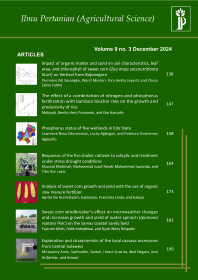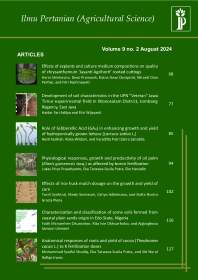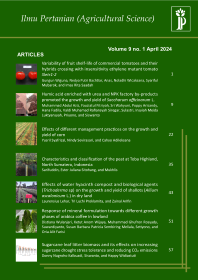Callus Induction on True Shallot Seed Explant Using a Combination of BA and 2,4-D
Krisna Dharmayanti(1), Endang Sulistyaningsih(2*), Rani Agustina Wulandari(3)
(1) Department of Agronomy, Faculty of Agriculture, Universitas Gadjah Mada Jln. Flora no. 1, Bulaksumur, Sleman, Yogyakarta 55281
(2) Department of Agronomy, Faculty of Agriculture, Universitas Gadjah Mada Jln. Flora no. 1, Bulaksumur, Sleman, Yogyakarta 55281
(3) Department of Agronomy, Faculty of Agriculture, Universitas Gadjah Mada Jln. Flora no. 1, Bulaksumur, Sleman, Yogyakarta 55281
(*) Corresponding Author
Abstract
Keywords
Full Text:
PDFReferences
Bhojwani, S.S. and P.K. Dantu. 2013 Plant Tissue Culture: An Introductory Text. Springer, London. [online] Available at: http: //www. khuisf.ac.ir/ prof/images/Uploaded_files/()Sant Saran Bhojwani, Prem Kumar Dantu (auth.)-Plant Tissue Culture_ An Introductory Text Springer India (2013)[3811896].PDF. [Accessed 15 May 2017].
Chaudhury, A. and R. Qu, 2000. Somatic embryogenesis and plant regeneration of turf-type bermudagrass: effect of 6-benzyladenine in callus induction medium. Plant Cell, Tissue and Organ Culture. 60, pp. 113–120.
Chauhan, M.and S.L. Kothari. 2004. Optimization ofnutrient levels in the medium increase the efficiency of callus induction and plant regeneration in recalcitrant Indian barley (Hordeum vulgareL.) in vitro. In VitroCellular and Developmental Biology-Plant. 40, pp. 520–527.
Duval Y., T.D. Gosselin, K. Konan and C. Pannetier. 1988. In vitro vegetative micropropagation of oil palm (Elaeisguineensis Jacq.). Strategy and Results. Proceedings of the 1987 Internation Oil Palm/Palm Oil Conference (Agriculture), Bangi. Malaysia.
Flick, C.E., D.A. Evans, and W.R. Sharp. 1993. Organogenesis in D.A. Evans, W.R. Sharp, P.V. Amirato, and T. Yamada (eds.). Hand book of Plant Cell Culture. London: Collier Macmillan Publisher.
Hailekidan, B., M. Andargie, and K. Assefa. 2013. In vitro plantlet regeneration from the bulbs of shallot (Allium cepa var. group Aggregatum). Research in Plant Science. 1, pp. 45–52.
Jouanneau, J.P. 1971 Côntrole par les cytokinines de la synchronisation des mitoses dans les cellules de tabac. Exp. Cell Res., 67, pp. 329–337.
Kaeppler, S.M., H.F. Kaeppler, and Y. Rhee . 2000. Epigenetic aspects of somaclonal variation in plants. Plant Mol. Biol., 43, pp. 179–188.
Kikuchi A., N. Sanuki , K. Higashi, T. Koshiba, and H. Kamada . 2006. Abscisic acid and stresstreatment are essential for the acquisition ofembryogenic competence by carrot somatic cells. Planta 223: 637-645.
Larkin, P.J. and W.R. Scowcroft. 1981. Somaclonal variation a novel source of variability from cell cultures for plant improvement. Theor. Appl. Genet, 60, pp. 197–214.
Leva, A.R., R. Petruccelli & L.M.R. Rinaldi. 2012. Somaclonal Variation in Tissue Culture: A Case Study With Olive. Recent Advance in Plant In Vitro Culture. 10–17.
Niizeki, M. and L. Zhongen. 2003. Somaclonal variation as a tool for plant breeding and genetics. Bull. Fac. Agric. And Life Sci. Hirosaki Univ., 6, pp. 1–7.
Salisbury, F.B and C.W. Ross. 1995. Fisiologi tumbuhan.3 th ed. Bandung: ITB.
Shah, M.I., M. Jabeen, and I Ilahi . 2003.In vitro callus induction, its proliferation and regeneration inseed explants of Wheat (Triticum aestivum L.) Var.Lu-26s. Pakistan Journal of Botany,35, pp. 209–217.
Sharma, V.K., R. Hansch, R.R. Mendel, and J. Schulze. 2005. Mature embryo axis based high-frequency somatic embryogenesis and plant regeneration from multiple cultivars of barley ( Hordeum vulgare L.). J. Exp. Bot., 56, pp. 1913–1922.
Skirvin, R.M., Norton, M. and Mcpheeter, K.D. (1993). Somaclonal variation: Has it proved useful for plant improvement. Acta Hort., 336, pp. 333−340.
Sukmadjaja, D. and Ade, M. 2011. Pertunasan dan pertumbuhan beberapa varietas tebu (Sacharum officinarum L.) secara in vitro. Bogor: Balai Besar Penelitian dan Pengembangan Bioteknologi Sumberdaya Genetik Pertanian.
Sulistyaningsih, E., Aoyagi, Y.and Tashiro, Y. 2006. Flower bud culture of shallot (Allium cepa L. Aggregatum group) with cytogenetic analysis of resulting gynogenic plants and somaclones. Plant Cell Tiss Organ Cult., 86, pp. 248–25.
Triharyanto, E. and Purnomo, D. 2014. Study of viability and seed structure of shallot. Journal of Agricultural Science and Technology, 4, pp. 121–125.
Article Metrics
Refbacks
- There are currently no refbacks.
Ilmu Pertanian (Agricultural Science) ISSN 0126-4214 (print), ISSN 2527-7162 (online) is published by Faculty of Agriculture Universitas Gadjah Mada collaboration with Perhimpunan Sarjana Pertanian Indonesia (PISPI) and licensed under a Creative Commons Attribution-ShareAlike 4.0 International License.













